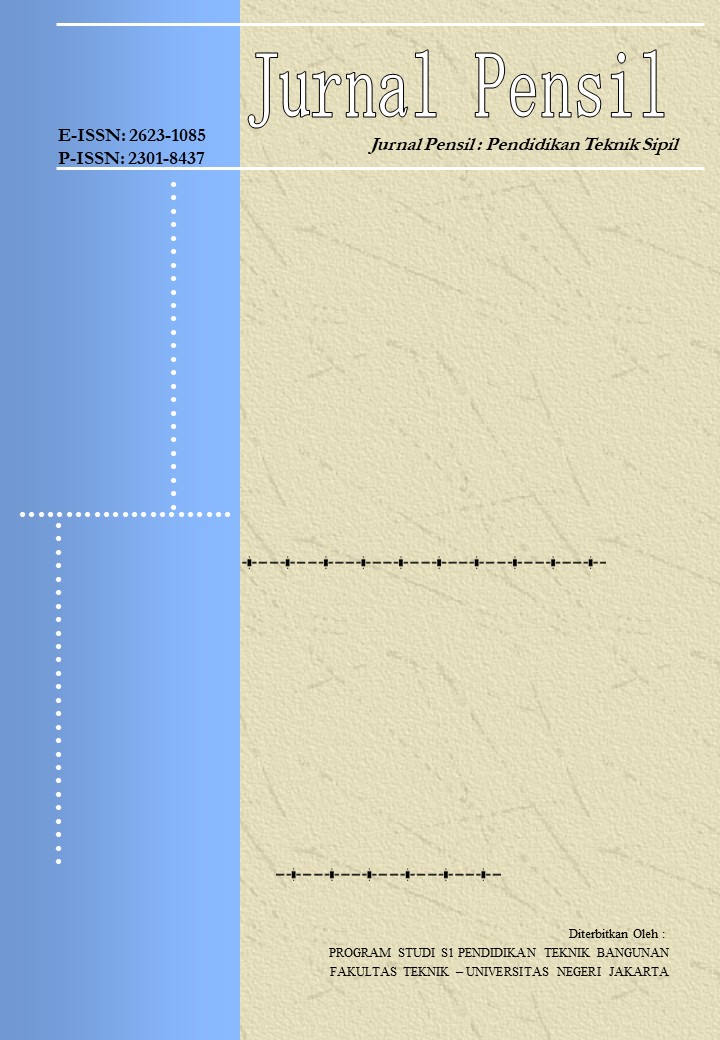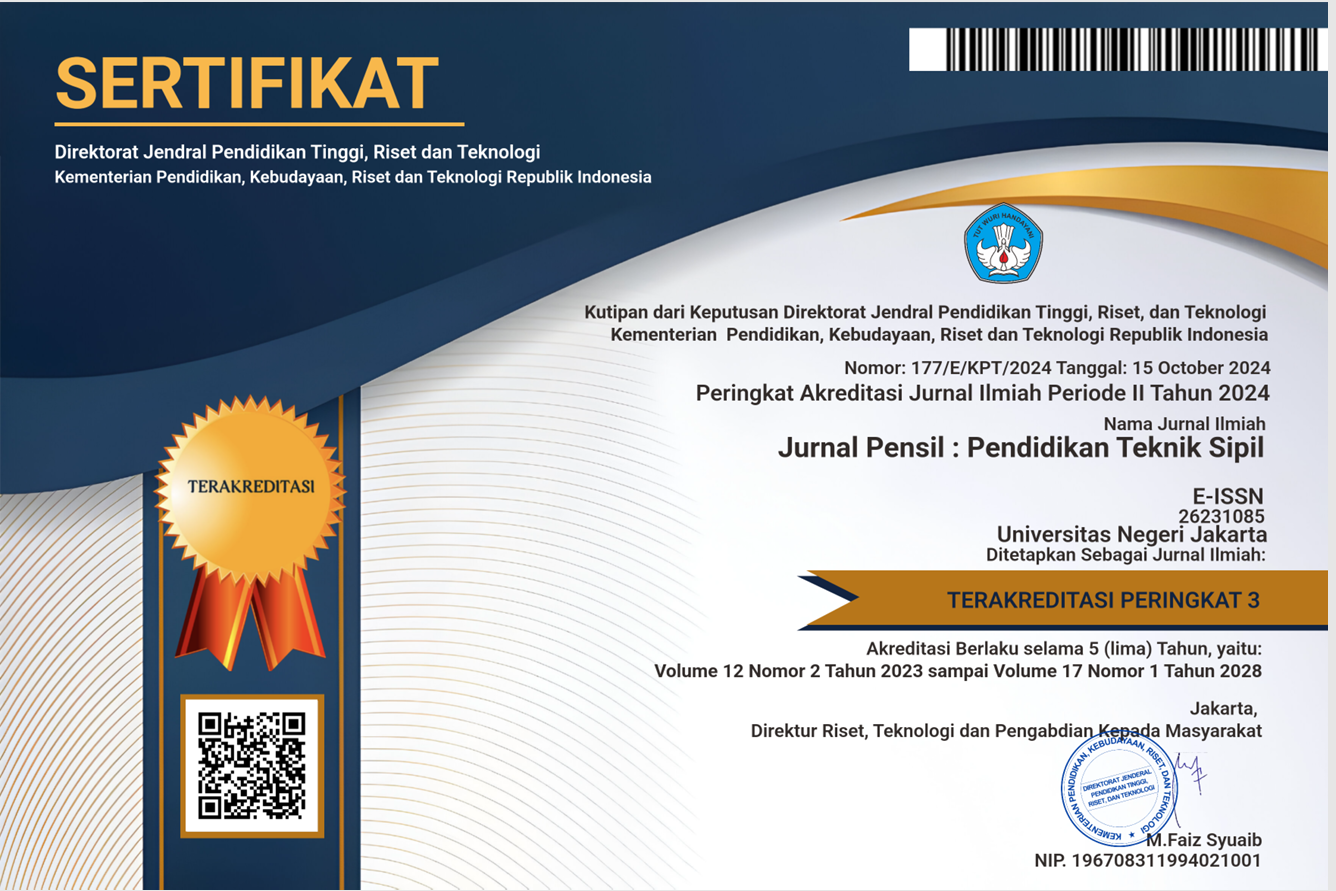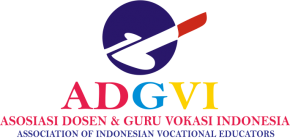THE DEVELOPMENT OF E-MODULE SOFTWARE AND BIM-BASED BUILDING INTERIOR DESIGN
DOI:
https://doi.org/10.21009/jpensil.v11i3.26298Keywords:
Teaching Materials, E-Modules, Software, Building Interior Design, BIMAbstract
This research aims to develop e-module for Software and Building Interior Design subjects based on Building Information Modeling (BIM) using the ArchiCAD software. The method used was the research and development method (R&D) from Thiagarajan which has 4 stages, namely define, design, develop, and dissemination. The data analysis technique uses instruments for expert appraisal. The developmental testing of e-module is used to determine the effectiveness of using e-modules software and BIM-based building interior design by users. This test was carried out by two selected schools, which consisted of 52 students. The results shows percentage of material expert validation obtained was 89% and the percentage of media expert validation was 84.58% and the effectiveness of the e-module reaches 0,84 in the n-gain score and 90.4%, which means the e-module are very feasible and can be used in the learning process of Software and Building Interior Design subjects.
References
Aisyah, N. (2011). Values Implemented By Secondary Teachers. 978–979.
Akhmadi, L. (2019). Pengembangan E-Modul Pada Mata Pelajaran Komputer dan Jaringan Dasar Untuk Kelas X Program Keahlian Teknik Komputer dan Jaringan Di SMK Negeri 2 Malang Dengan Model Pengembangan Four-D. Jurnal Pengembangan Teknologi Informasi Dan Ilmu, 3(4), 3879–3879.
Al Fitani, M. S., & Gazali, Z. (2021). Pengembangan Media Pembelajaran Berbasis Audio Visual Untuk Siswa Kelas X Ipa. JISIP (Jurnal Ilmu Sosial Dan Pendidikan), 5(3). https://doi.org/https://doi.org/10.36312/jisip.v5i3.2243
Asmi, A. R., Dhita Surbakti, A. N., & C., H. (2018). E-Module Development Based Flip Book Maker For Character Building In Pancasila Coursework Sriwijaya University. JURNAL PENDIDIKAN ILMU SOSIAL, 27(1), 1. https://doi.org/10.17509/jpis.v27i1.9395
Bosch-Sijtsema, P., Claeson-Jonsson, C., Johansson, M., & Roupe, M. (2021). The hype factor of digital technologies in AEC. Construction Innovation. https://doi.org/10.1108/CI-01-2020-0002
BPSDM PU. (2018). BIM Execution Plan (BEP) Sebagai Bagian Dari Proses Penyajian Informasi.
Cahyanto, B., & Afifulloh, M. (2020). Electronic Module (E-Module) Berbasis Component Display Theory (CDT) Untuk Matakuliah Pembelajaran Terpadu. JINOTEP (Jurnal Inovasi Dan Teknologi Pembelajaran): Kajian Dan Riset Dalam Teknologi Pembelajaran, 7(1), 49–56. https://doi.org/10.17977/um031v7i12020p049
Dewi, W. A. F. (2020). Dampak COVID-19 terhadap Implementasi Pembelajaran Daring di Sekolah Dasar. Edukatif : Jurnal Ilmu Pendidikan, 2(1), 55–61.
Febro, J. D., Catindig, M. A. C., & Caparida, L. T. (2020). Development of e-learning module for ICT skills of marginalized women and girls for ICT4D. International Journal of Emerging Technologies in Learning. https://doi.org/10.3991/ijet.v15i16.14929
Gay, L. R., & Airasian, P. (2003). Educational research, competencies for analysis and applications, (7th ed.). Merrill Prentice Hall.
H, N., Hakim, A., & Wahid, M. S. (2021). Interactive E-Module Development in Multimedia Learning. AL-ISHLAH: Jurnal Pendidikan, 13(3), 2293–2300. https://doi.org/10.35445/alishlah.v13i3.863
Hikmah, N. (2019). Pengembangan Modul Interaktif Berbasis Kvisoft Flopbook Maker Mata Pelajaran Sejarah Kelas X SMA Menggunakan Model Pengembangan 4D. In Digital Repository Universitas Jember.
Holmes, K., & Crossley, M. (2004). Whose knowledge, Whose values? The contribution of local knowledge to education policy processes: A case study of research development initiatives in the small state of Saint Lucia. Compare, 34, 193–208. https://doi.org/10.1080/0305792042000214010
Imbatami, R. I., Murtinugraha, R. E., & Arthur, R. (2020). Pengembangan Modul Elektronik Pada Materi Rancangan Penelitian Untuk Prodi Pendidikan Teknik Bangunan UNJ.
Indrianus, W., Daryati, & Rochadi, D. (2020). Pengembangan Modul Elektronik Pada Mata Kuliah Gambar Teknik 1 Di Prodi Pendidikan Vokasional Konstruksi Bangunan Universitas Negeri Jakarta.
Kurniawan, D., Dewi, S. V., Pendidikan, J., Fakultas, M., Dan, K., Pendidikan, I., & Siliwangi, U. (2017). Pengembangan Perangkat Pembelajaran Dengan Media Screencast- O-Matic Mata Kuliah Kalkulus 2 Menggunakan Model 4-D Thiagarajan. Jurnal Siliwangi, 3(1), 214–219.
Lim, J. S. C., Jailani Md Yunos, & Ghazally Spahat. (2005). The Development and Evaluation of an E-Module for Pneumatics Technology. Malaysian Online Journal of Instructional Technology (MOJIT), 2(3), 25–33.
Masdayaroh, M., Iriani, T., & Saleh, R. (2022). EFFECTIVENESS OF THE USE OF MULTIMEDIA-BASED LEARNING MEDIA IN BUILDING CONSTRUCTION COURSES. Jurnal PenSil, 11(2), 152–161. https://doi.org/https://doi.org/10.21009/jpensil.v11i2.26225
Murase, M., Tyagi, A. C., Saalmueller, J., & Nagata, T. (2008). ORGANIZING COMMUNITY PARTICIPATION FOR FLOOD MANAGEMENT A Tool for Integrated Flood Management. Management, ORGANIZING(March 2008), 1–10.
Oktaviyanthi, R., Safaah, E., & Noviana Agus, R. (2017). Pemberdayaan Keterampilan Guru Matematika dalam Menyusun Bahan Ajar Berbantuan Mathematics Education Software. Wikrama Parahita:Jurnal Pengabdian Masyarakat, 1(1), 19–24. https://doi.org/10.30656/jpmwp.v1i1.270
Permana, Y. (2017). Pengembangan Modul Pembelajaran Autocad Dengan Konsep Pembelajaran Berbasis Proyek Di Jurusan Teknik Arsitektur SMK Negeri 2 Wonosari. Jurnal Pendidikan Teknik Sipil Dan Perencanaan, 1–10.
Prasetiyowati, Y., & Tandyonomanu, D. (2015). Pengembangan Modul Elektronik Pada Mata Pelajaran Animasi 3 Meningkatkan Hasil Belajar Di SMK Negeri 1 Magetan. Jurnal Mahasiswa Teknologi Pendidikan, 6(2), 1.
Prasetyo, A. D. J., & Ramadhan, M. A., Sumarsono, R. A. (2021). Pengembangan E-Modul Berbasis BIM pada Mata Pelajaran Aplikasi Perangkat Lunak dan Perancangan Interior Gedung Di SMKN 52 Jakarta. Universitas Negeri Jakarta.
Pratiwi, S. S., Purwasih, J. H. G., Rozakiyah, D. S., Apriyadi, D. W., & Utami, I. W. P. (2021). Developing E-Module for Prospective Sociology Educators: Constructing Multiple Choice Questions Based on Higher Order Thinking Skill (HOTS). International Journal of Emerging Technologies in Learning, 16(7), 249–256. https://doi.org/10.3991/ijet.v16i07.21197
PUPR, B. (2020). Mendukung Peran SMK dalam Dunia Konstruksi Masa Depan. http://bim.pu.go.id/berita/baca/55/materi.htm
PUPR, B. K. P. K. (2020). Tingkatkan Pemanfaatan Teknologi Konstruksi Berbasis Industri 4.0 Kementrian PUPR Gelar Pelatihan Jarak Jauh Penerapan BIM. https://pu.go.id/berita/tingkatkan-pemanfaatan-teknologi-konstruksi-berbasis-industri-4-0-kementrian-pupr-gelar-pelatihan-jarak-jauh-penerapan-bim
Qureshi, M. I., Khan, N., Raza, H., Imran, A., & Ismail, F. (2021). Digital Technologies in Education 4.0. Does it Enhance the Effectiveness of Learning? International Journal of Interactive Mobile Technologies, 15(4), 31–47. https://doi.org/10.3991/IJIM.V15I04.20291
Rahdiyanta, D. (2016). Teknik Penyusunan Modul. 1–14.
Ramadhan, M. A., & Maulana, A. (2020). Pemahaman Konsep BIM melalui Autodesk Revit bagi Guru SMK Teknik Bangunan se-Jabodetabek. Wikrama Parahita : Jurnal Pengabdian Masyarakat, 4(1), 47–52. https://doi.org/10.30656/jpmwp.v4i1.1886
Ramadhan, M. A., & Murtinugraha, R. E. (2020). The Development of E-Module on Subject of Statistics in Study Program Civil Engineering Eduaction, Universitas NEGERI Jakarta. BALANGA: Jurnal Pendidikan Teknologi Dan Kejuruan, 8(2), 70–74. https://doi.org/10.37304/balanga.v8i2.1908
Reflianto, & Syamsuar. (2018). Pendidikan dan Tantangan Pembelajaran Berbasis Teknologi Informasi di Era Revolusi Industri 4.0. Jurnal Ilmiah Teknologi Pendidikan, 6(2), 1–13.
Riduwan, S. (2011). Pengantar Statistika Untuk Penelitian Pendidikan, Sosial, Ekonomi, Komunikasi, dan Bisnis. Alfabeta.
Setiami, R., & Maulana, A. (2021). Development of E-Modules in Engineering Drawing Courses With the Bim System Building Modeling Application. Jurnal PenSil, 10(1), 1–7. https://doi.org/10.21009/jpensil.v10i1.17013
Siahaan, A. (2018). Pengembangan Modul Pembelajaran Pada Kompetensi Autocad Siswa SMK. Jurnal Teknologi Informasi & Komunikasi Dalam Pendidikan, 4(1), 13–23. https://doi.org/10.24114/jtikp.v4i1.8748
Sibuea, A. M. (2000). Pengajaran Dengan Modul Berdasarkan Kompetensi. Medan: Jurnal Pengabdian Kepada Masyarakat, 6(22).
Subiyantari, A. R., Muslim, S., & Rahmadyanti, E. (2019). Effectiveness of Jigsaw Cooperative Learning Models In Lessons of the Basics of Building Construction on Students Learning ’Outcomes Viewed From Critical Thinking Skills. International Journal for Educational and Vocational Studies, 1(7), 691–696. https://doi.org/10.29103/ijevs.v1i7.1653
Suyatno, Jumintono, Pambudi, D. I., Mardati, A., & Wantini. (2019). Strategy of values education in the Indonesian education system. International Journal of Instruction. https://doi.org/10.29333/iji.2019.12139a
Taplin, M. (2002). Can we, should we, and do we integrate values education into adult distance education? Opinions of stakeholders at the open university of Hong Kong. International Journal of Lifelong Education, 21(2), 142–161. https://doi.org/https://doi.org/10.1080/02601370110111709
Tubielewicz-Michalczuk, M. (2019). Fence Designs with ArchiCAD Software. IOP Conference Series: Materials Science and Engineering, 471(8). https://doi.org/10.1088/1757-899X/471/8/082001
Wahyuni, E. S., Rahmayanti, H., & Ichsan, I. Z. (2021). Hubungan Berpikir Kritis Dan Motivasi Belajar Terhadap Hasil Belajar Di Masa Pandemi Covid 19. Jurnal PenSil, 10(3), 120–129. https://doi.org/10.21009/jpensil.v10i3.19275











.png)
.png)
1.png)

